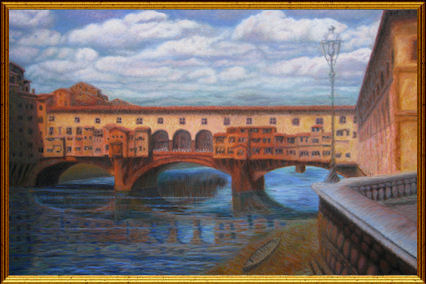Click on any thumbnail below to see a larger version of the picture
"Ponte Vecchio 2012"

After visiting the Pissarro exhibition at the Legion of Honor in San Francisco,
I decided to redo my Ponte Vecchio painting in an impressionist style.
Below - Detail of painting to show the texture.
The paint was applied in thin strokes, layer upon layer,
both wet-on-wet as well as wet over dry, with no blending.
Above left, low resolution Above right, high resolution
Below - Closeup showing paint strokes for water and the bridge.
The strokes used for water are more sophisticated than the strokes for the bridge..
Above left, low resolution Above right, high resolution
Below - Close-up of the lower right portion of the painting. Here the paint strokes
can be seen to be most varied. I took into consideration the composition of the material,
the reflectiveness, and the perceived distance from the viewer, when choosing paint strokes.
Above left, low resolution Above right, high resolution
Below - The final painting
Above left, low resolution Above right, high resolution
![]()
Anatomy of the painting "Ponte Vecchio"
The current bridge was rebuilt after a flood in 1345. During World War II it was the only bridge across the Arno that the fleeing Germans did not destroy. Instead they blocked access by demolishing the medieval buildings on each side. On November 4, 1966, the bridge miraculously withstood the tremendous weight of water and silt when the Arno once again burst its banks.
When the Medici moved from Palazzo Vecchio to Palazzo Pitti, they decided they needed a connecting route from the Uffizi to the Palazzo Pitti on the other side of the Arno that would enable them to keep out of contact with the people they ruled. The result was the Corridoio Vasariano, built in 1565 by Vasari and which runs above the little goldsmiths' shops on the Ponte Vecchio.
The Ponte Vecchio (Old Bridge) is one of the most famous sites in Italy. When I decided to represent it in a painting, my first thought was that I needed to be fairly accurate in its portrayal as it looks today. So I chose three of my photos that I liked, to help me sketch a pleasant compositon.
Click on the pictures below to see the large size
Above - I started with three photos from my trip to Florence. I liked parts of each.
Below - I sketched a composite and turned it into a line drawing on the computer.
I knew I would be removing some details, but I wanted to start with everything.
Above - The parts I liked from the photos are composed.
Below - The first sketch was just to block in the parts and determine rough colors.
It's easier to cover up water reflections than to try to add them later.
Above - I know the final color of the balcony won't be gray, but it's a start.
Below - The second layer of paint better establishes the details before I get painterly.
Above - It's still just a sketch. Eventually, the painting will contain stacks of colors - one on top of another.
Below - The colors are more firmly established, and the clouds are more defined.
Above - The lower half of the painting is still not defined.
Below - The river was added, and the clouds were simplified.
Above - A comparison of the painting before and after impressionist strokes
and layers of new paint were added. It is definitely more painterly.
I have wonderful memories of this bridge including a great nighttime concert.